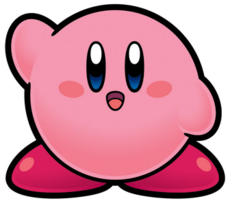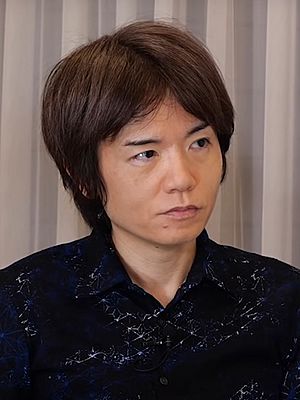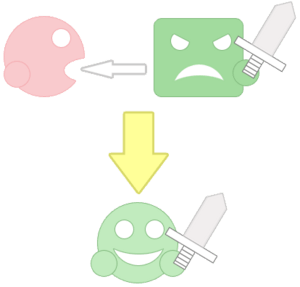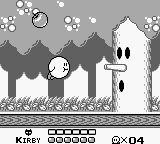Kirby (character) facts for kids
Quick facts for kids Kirby |
|
|---|---|
| Kirby character | |

Artwork of Kirby from Kirby Super Star Ultra
|
|
| First game | Kirby's Dream Land (1992) |
| Created by | Masahiro Sakurai |
| Designed by | Masahiro Sakurai |
| Voiced by | Makiko Ohmoto (1999–present) |
| Information | |
| Gender | Male (in localizations) Unknown (in Japan) |
| Home | Dream Land, Planet Popstar |
Kirby (Japanese: カービィ, Hepburn: Kābī) is a super cute and powerful character from Nintendo video games! He is the main hero of the Kirby series, created by HAL Laboratory. Kirby first appeared in 1992 in a game called Kirby's Dream Land for the Game Boy.
Since then, Kirby has starred in over 50 games. These games include exciting action platformers, tricky puzzle games, fast racing games, and even pinball adventures. He is also a popular playable character in every Super Smash Bros. fighting game. You might have also seen him in his own anime TV show and manga comics. Since 1999, the talented Makiko Ohmoto has given Kirby his voice.
Kirby's most famous power is his ability to inhale (suck up) objects or enemies. He can then spit them out like powerful projectiles! He can also suck in air to float high above obstacles. His special Copy Ability lets him gain the powers of the creatures he inhales. When he does this, he often changes his look with fun costumes or transformations. Kirby uses these amazing skills to save his home, Planet Popstar, and other lands from bad guys like Dark Matter or Nightmare. On his journeys, he often meets his friendly rivals, King Dedede and Meta Knight. Kirby is known for being cheerful, innocent, and absolutely loving food!
Many people think Kirby is one of the most iconic and lovable video game characters ever. He is super popular with gamers, especially in Japan. People also praise him for being very versatile, meaning he fits well into many different types of games.
Discover Kirby: Nintendo's Pink Hero
How Kirby Was Created

Kirby was created by Masahiro Sakurai when he was just 19 years old. Sakurai was working at HAL Laboratory in May 1990. He designed Kirby to be the main character for the 1992 game Kirby's Dream Land.
At first, Kirby's design was a simple ball shape. It was meant to be a temporary drawing for the game's hero. But Sakurai liked the simple design so much that he decided to keep it! During development, Kirby was called "Popopo." The first game was even planned to be named Harukaze Popopo. Later, Nintendo got involved and suggested changing the name to appeal to players around the world. They chose the name "Kirby" from a list of ideas. It's said that the name was partly chosen to honor an American lawyer named John Kirby.
Designing Kirby's Look
Masahiro Sakurai wanted to create "a cute main character who everyone will love." Satoru Iwata, another important person at Nintendo, said that Kirby's simple, round design makes him easy for anyone to draw. The BBC even mentioned that Kirby's design is "expressive, iconic, instantly-recognisable, and easy for kids to draw."
In his very first game, Kirby's Dream Land, Kirby looked white. This was because the Game Boy system only showed shades of grey. But Sakurai always imagined Kirby as pink! Shigeru Miyamoto, another famous Nintendo creator, thought Kirby might be yellow. However, he agreed that pink was a more unique and fun choice. Sometimes, in games with more than one player, other Kirbys appear in different colors, like yellow.
Sakurai explained that he wanted Kirby to fly. He thought it would be unfair for players to lose a life just by missing a jump. He also thought about Kirby using his tongue to grab enemies, like Yoshi. But he decided that inhaling and spitting them out was a better idea. For the second game, Kirby's Adventure, the team started with over 40 different Copy Abilities. They then chose the best ones for the final game.
HAL Laboratory's director, Shinya Kumazaki, mentioned that Kirby is a "neutral" character. This means he's designed to show the player's feelings in the game. He doesn't show very strong emotions that might clash with how the player feels. For a while, in North America, Kirby looked more serious in game pictures. This was to make him appeal to more players. But in Japan, he always looked cheerful.
Making Kirby a 3D character was a bit tricky because of his round shape. It was hard to tell which way he was facing from behind. This made it difficult to aim his inhale attacks. So, for Kirby and the Forgotten Land, a special system was added to help players target enemies easily. The idea for Mouthful Mode came from exploring Kirby's shape-shifting nature. The team wanted him to have amazing, non-human abilities. Even though he can hold huge objects, there are still rules about what he can swallow. The main goal for every Kirby game is to make Kirby the hero. He is like a blank slate, pure and ready for any adventure!
Kirby's Voice Actor
Since the game Kirby 64: The Crystal Shards in 2000, Kirby has been voiced by the Japanese actress Makiko Ohmoto. She also voices him in all the Super Smash Bros. games, starting from the very first one in 1999.
What Makes Kirby Special
Kirby lives on a yellow star called Planet Popstar, in a place called Dream Land. He has a round, pink body with tiny arms and big red feet. His body is super soft and flexible! He can stretch, flatten, and change his shape. He can open his mouth incredibly wide to inhale enemies. He can also puff himself up with air to fly. Even though he's so stretchy, some parts, like the distance between his eyes, stay the same to keep him looking cute.
Kirby is known for his innocent, childlike personality and his huge appetite. When he swallows enemies, they don't get digested. Instead, they just disappear and pop up somewhere else in the game world. Kirby is officially about 20 centimeters (or 8 inches) tall.
Kirby's gender is often listed as "unknown" in official Japanese guides. His creator, Masahiro Sakurai, even joked about whether Kirby could be female. Makiko Ohmoto, his voice actress, also says Kirby's gender is unknown. She just plays the character as "Kirby." In English game manuals, Kirby is sometimes called a "little boy." However, the Japanese versions use a word that means "youngster" or "young person," which can be for any gender.
When asked about what kind of being Kirby is, Kumazaki said he is an "always-shifting and mysterious individual." Another producer, Tadashi Kamitake, said Kirby has a unique personality but is also like a blank sheet of paper. He can transform into anything he sucks up. This means he can be an unstoppable superhero and a friendly companion at the same time!
Kirby's Amazing Powers
Kirby's main power is inhaling enemies and objects. He can then either swallow them or spit them out with incredible force. He can also fly by puffing himself up with air.
The game Kirby's Adventure introduced the famous Copy Ability. This lets Kirby copy the powers of his enemies by swallowing them! For example, he can breathe fire or become a skilled swordsman. Instead of finding power-ups, Kirby uses his enemies as power-ups. Kirby Super Star made Copy Abilities even better, giving Kirby many different moves for each power. In that game, Kirby could even create a "Helper" from his current Copy Ability. This Helper could be controlled by the computer or a second player.
Kirby Star Allies (released in 2018) had a similar idea. Kirby could throw small pink hearts at enemies to turn them into allies! Since Kirby's Adventure, many different Copy Abilities have been added. These give Kirby tons of powers and fun costumes. Some examples include:
- Sword: Kirby gets a sword and looks like Link.
- Artist: His drawings come to life!
- Needle: He wears a spiky hat and can shoot spikes.
Kirby and the Forgotten Land (2022) took Kirby's skills even further. Players could upgrade his Copy Abilities multiple times, making them super powerful. For instance, his Fire ability could become Volcano Fire and then Dragon Fire! This game also introduced Mouthful Mode. In this mode, Kirby expands his mouth to fit around huge objects, like a car. He then takes on their shape and uses their functions!
Kirby's Adventures in Games
Kirby has been the star of the Kirby series since 1992. Most Kirby games are platform games, where you jump and run through levels. But his games also include many other types, like pinball, fighting, racing, and puzzle games. Throughout his adventures, Kirby battles many enemies, including the mischievous penguin, King Dedede.
Early Games and New Abilities
Kirby's first game, Kirby's Dream Land, came out on the Game Boy in 1992. It was a 2D platformer that showed off his famous ability to suck up, swallow, and spit out enemies. He could also run, jump, and fly. Food items in the game gave him temporary powers. At the end of each level, Kirby faced a boss, like Whispy Woods or King Dedede. Because the Game Boy screen was black and white, Kirby appeared grey in the game.
A year later, Kirby's Adventure on the NES introduced his amazing Copy Ability. He also gained new moves like dashing and slide kicks. This game also brought in his recurring rival, Meta Knight. Kirby looked pink in this game, which was his intended color! He fought King Dedede again and also had to defeat a creature called Nightmare.
In 1995, Kirby's Dream Land 2 for the Game Boy introduced animal friends: Rick the hamster, Coo the owl, and Kine the fish. They helped Kirby on his adventure. Kirby appeared grey in the game again, but he was pink on the box art. He battled a boss called Dark Matter.
Kirby Super Star (1996) for the Super Nintendo Entertainment System was a collection of eight mini-games. One fun game was Gourmet Race, where Kirby raced King Dedede to collect food. This game was the first to let Kirby create "helpers" from his Copy Abilities. It also gave Kirby different hats to show off his powers!
Modern Kirby Games
Kirby 64: The Crystal Shards (2000) on the Nintendo 64 was Kirby's first game with 3D graphics. Kirby became perfectly round! His skills got an upgrade, allowing him to combine two abilities for stronger or new effects.
In Kirby: Squeak Squad (2006) for the Nintendo DS, Kirby could swallow multiple abilities and combine them. He could also upgrade his skills using Ability Scrolls. Kirby's Return to Dream Land (2011) on the Wii brought back the classic gameplay with four-player fun. Kirby gained a powerful Super Inhale move by shaking the Wii Remote.
Kirby: Triple Deluxe (2014) on the Nintendo 3DS introduced new Copy Abilities like Beetle and Archer. When Kirby collected a Miracle Fruit, he transformed into Hypernova Kirby, letting him inhale much bigger objects! In Kirby: Planet Robobot (2016), Kirby got a cool mech suit called the Robobot Armor. This armor made him even stronger and could also copy abilities.
Kirby Star Allies (2018) for the Nintendo Switch was designed for four players to team up. Kirby could turn enemies into allies by throwing hearts at them. Finally, Kirby and the Forgotten Land (2022) on the Switch moved Kirby into a fully 3D world. This game introduced the amazing Mouthful Mode, where Kirby can inhale large objects and take on their shape and powers!
Kirby in Spin-off Games
Kirby has starred in many different kinds of spin-off games.
- In 1993, he became a pinball in Kirby's Pinball Land.
- In 1994, he was a golf ball in Kirby's Dream Course.
- Kirby's Avalanche (1995) was a puzzle game where you matched falling colored blobs.
- Kirby's Block Ball (1995) was like a game of Breakout with Kirby.
- Kirby's Epic Yarn (2010) changed Kirby into an outline made of yarn!
- Kirby Mass Attack (2011) let you control up to ten Kirbys at once by tapping the screen.
- Kirby and the Rainbow Curse (2015) on the Wii U had you draw paths for Kirby with a stylus.
- Recent spin-offs include Kirby Battle Royale (2017), Super Kirby Clash (2019), Kirby Fighters 2 (2020), and Kirby's Dream Buffet (2022), which is a fun racing game where Kirbys eat strawberries.
Kirby in Super Smash Bros. and Other Games
Kirby is a playable character in every single Super Smash Bros. fighting game, which was also created by Masahiro Sakurai. In these games, Kirby can copy the abilities and looks of his opponents, like Mario, Donkey Kong, Link, and Samus.
In Super Smash Bros. Ultimate, Kirby has a very important role in the "World of Light" story mode. He is the only character who survives a huge attack, thanks to his Warp Star! His creator, Sakurai, said Kirby was the perfect choice because his Warp Star gave a good reason for his escape. In Super Smash Bros. Brawl (2008), Kirby's special move was his Cook ability, which cooked opponents in a pot. In later games like Super Smash Bros. for Nintendo 3DS and Wii U (2014) and Super Smash Bros. Ultimate (2018), Kirby's special move became an Ultra Sword attack.
Kirby has also made small appearances in other video games. A pink Kirby character can be seen in The Legend of Zelda: Link's Awakening. He also appeared in the opening of Arcana in 1992 and in the Pokémon Stadium games.
Kirby Beyond Video Games
Kirby also stars in his own anime TV show called Kirby: Right Back at Ya! (known as Hoshi no Kābī in Japan). This show aired from 2001 to 2003 in Japan and from 2002 to 2006 in the United States, with 100 episodes. The anime is based on the games but has some differences. Like in the games, anime Kirby doesn't speak in full sentences and acts like a baby. He is called a "Star Warrior" and his Copy Ability is powered by his Warp Star. The series starts with him crashing his Starship in Cappy Town on Planet Popstar, where he becomes friends with Tiff and Tuff. In the story, he meets the greedy King Dedede, the mysterious Meta Knight, and faces the main villain, eNeMeE.
Kirby also appears in several manga comic series. The longest-running one, Kirby of the Stars: The Story of Dedede Who Lives in Pupupu, was published from 1994 to 2006. It has sold over 10 million copies! This series continued in 2017. A "best-of" collection of this manga, including new chapters, was published in English as Kirby Manga Mania.
See also
 In Spanish: Kirby (personaje) para niños
In Spanish: Kirby (personaje) para niños



